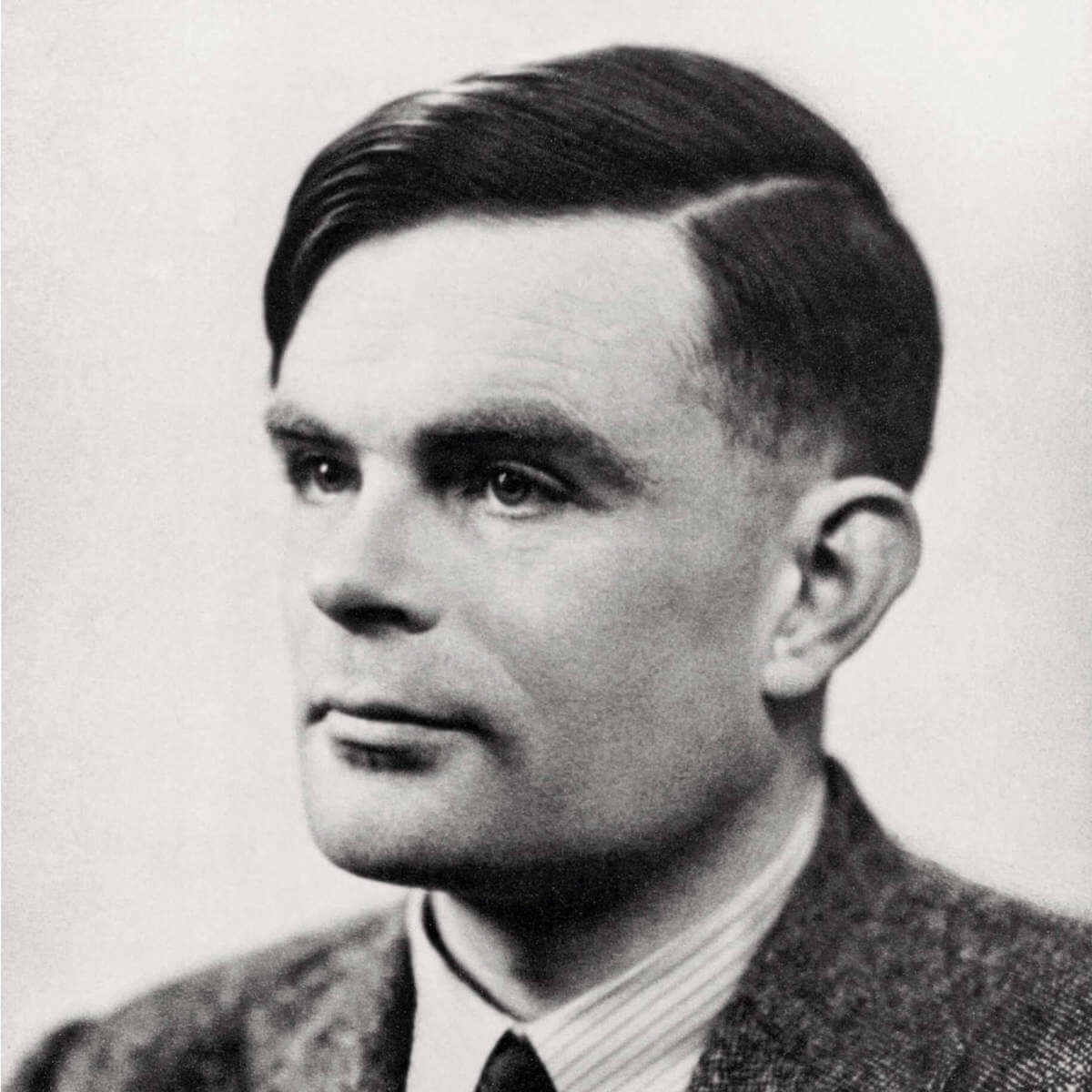

Many of our readers may well know of Alan Turing and his accomplishments, and we’ll be covering some of them today. But some people are unaware of the truly unfortunate moments in his later life, and this will make up the bulk of the article, because we’re obviously Unfortunate History.
That being said, I still want to talk a bit about Turing’s amazing accomplishments from throughout his life. It’s not an exaggeration to say that we all owe Alan Turing a debt of gratitude, so it would be a crime to overlook the things he brought to the world during his lifetime.
Alan Turing was born in Maida Vale, London. His father, Julius Mathison Turing (interesting middle name) had a position in the Indian Civil Service and was also the son of a Scottish clergyman. Turing’s mother was Ethel Sara Turing. His mother’s family was descended from County Tipperary in Ireland, and I mention that to say this: the town of Tipperary is a pretty rough place. Not very pretty, by Ireland standards.
At an early age, Turing was said to show very interesting signs of genius. These signs have been described as the “personality disorder” that leads to such vocations as engineering and mathematics. There are a few examples of these interesting childhood signs.
For instance, Turing would sometimes bury his broken toys in hopes of resurrecting them. I’m not entirely sure why this would prove that someone is a genius, but it could be the inquisitive nature of the action. He was also said to have taught himself to read in just three at an early age. He also was obsessed with numbers and would stop at every street light in order to find its serial number. But let’s be honest, he sounds like a bit of a handful at this point.
Another anecdote from his childhood takes place at a family picnic when he was seven. He decided he wanted to get his family a bit of wild honey. So, he plotted the flight paths of nearby bees until he was able to find the intersection point which marked their hive. And yes, he did bring back the honey for his family.
One final example of his early genius nature was when he discovered the chain on his bicycle would regularly dislodge itself from the gears after the exact number of rotations. Initially, Turing would count the rotations as he rode, then stop and fix the chain before it would dislodge. However, this got a bit too tedious for him and he rigged a mechanical device that would keep the count and readjust the chain itself automatically.
During his time in school, he excelled in mathematics. So much so that Turing’s school was more annoyed with him than anything. They would have preferred that he studied the classics and felt that he was wasting his time in public education only learning mathematics. Even still, he was still noticed as a genius. For instance, at the age of 16, he was introduced to Albert Einstein’s work and was able to fully grasp the concepts. Most of this learning occurred at the Sherborne boarding school, which we’ll return to in a moment.
After he left school, he attended King’s College, Cambridge where he continued his studies in mathematics. Now, I will not go into a lot of detail of the things he accomplished during his time at university, because, quite frankly, I can’t really understand most of it. But the main points you should know is that: 1) He was a genius and 2) it was in university that he first published the idea of a “Universal Machine” which is now known as the universal Turing machine (UTM).
I can’t exactly explain the UTM in graphic detail, but it was essentially an automated machine that could be used to perform any algorithm, no matter how complicated.
The UTM was essentially one of the world’s first computing machines. It wasn’t a computer in the sense that we know today. However, Turing did, indeed, create computer science and the idea of the computer in a realised way.
Further to kickstarting the computing age, Alan Turing also put his talents to good use. On the outset of WWII, the day after the UK declared war on Germany, Turing reported to Bletchley Park. This was a station for the Government Code and Cypher School which Turing had been working for part time.
It was here that he developed, along with the help of senior codebreaker Dilly Knox, the bombe. This was a machine specifically designed to break German codes. The Germans had developed the Enigma machine, which was an incredibly difficult to crack encryption device for the time. Don’t ask me to explain how either machine worked, I just couldn’t possibly do it. But I can tell you that the bombe did indeed crack the Enigma codes. So much so that more than 200 Bombes were in operation by the end of the war.
Alan Turing’s seminal work during WWII was a major part of the Allied victory. In essence, he was a war hero of his own.
I can’t imagine what it would have been like to work with him. He was a genius, yes, but I can imagine his eccentricities would really irk you when you’re trying to prevent the destruction of the majority of the world. Here is a quick quote from one of Turing’s colleagues about his workplace eccentricities:
In the first week of June each year he would get a bad attack of hay fever, and he would cycle to the office wearing a service gas mask to keep the pollen off. His bicycle had a fault: the chain would come off at regular intervals. Instead of having it mended he would count the number of times the pedals went round and would get off the bicycle in time to adjust the chain by hand. Another of his eccentricities is that he chained his mug to the radiator pipes to prevent it being stolen.
But I don’t want to talk about that stuff anymore. I want to talk about Alan Turing’s personal life, because this is where the unfortunate portion of our story really lies. During his time working in WWII, Turing proposed to a fellow mathematician and cryptanalyst, Joan Clark. She said yes, but their engagement was very short lived. You see, Alan Turing was homosexual. Although, his fiancee was said to have been unfazed by the revelation. However, Turing felt that he could not go through with the marriage and the wedding was called off.
A lot of people know that homosexuality actually used to be a crime in England. This actually began under the reign of Henry VIII with the Buggery Act of 1533. This act outlawed all sodomy in the British Empire and convictions were punishable by death.
Death was not taken off the table for homosexual punishments until 300 years later in 1861. Instead, acts of sodomy were punishable by a minimum of 10 years in prison.
Twenty years later, another act made any male homosexual act illegal, whether or not a witness was present. This meant that even acts committed in private could be prosecuted. The wording of this act was so poor and ambiguous that it was referred to as the ‘Blackmailer’s Charter’ and even Oscar Wilde fell victim to it.
Interestingly enough, lesbianism was never explicitly targeted by any legislation. Do you know why that is? Well, on the one occasion that it was brought before Parliament, the House of Commons and the House of Lords rejected the notion because they feared that a law against it would encourage women to explore homosexuality. They also assumed that lesbianism was extremely rare in the female population. All the while their wives were likely scissoring hard enough to make campfires.
Homosexuality wasn’t legalised in the United Kingdom until the end of the 1960s.
Now, I mentioned a little earlier that we’d come back to Sherborne boarding school. Well, it was here that Alan Turing met Christopher Morcom. Turing and Morcom shared a significant friendship, and he has been described as Turing’s first love. It was Morcom who actually helped Turing move further in his pursuit of mathematics, which the two boys had both shared a passion for. Unfortunately, this friendship was cut short in February 1930, when Morcom drank infected cow’s milk giving him bovine tuberculosis.
The loss of Morcom really shook Turing, and it is not known if he had many other love interests in his life; except for one: Arnold Murray. Murray was a 19-year-old unemployed man that had started a relationship with Turing in 1952, when he was 39. Shortly after beginning their relationship, Turing’s house was burgled. The suspect was apparently known by Murray and Turing decided to report this to the police.
During the police’s investigation of the burglary, Turing acknowledged that he had a sexual relationship with Murray. Both men were arrested and charged with gross indecency. On the advice of his own lawyer, he entered a plea of guilty and was convicted. He was given the choice between imprisonment and probation. Which, of course you would likely choose the probation. However, the probation was conditional. He had to undergo chemical castration.
What chemical castration does is remove the testosterone from the body by injecting oestrogen. However, Alan Turing had to have injections of a synthetic oestrogen for a full year. This treatment rendered him impotent and also caused breast tissue to form.
Along with his body changes, Turing lost his security clearance and barred him from continuing any cryptographic consultancy for the government. He was also denied entry into the United States.
Eventually, this all became too much and Alan Turing decided to end his life. He was found 8 June 1954 by his housekeeper, dead at the age of 41. There was an inquest into his death that determined he had committed suicide. His cause of death was established as cyanide poisoning. Near his lifeless body was a half-eaten apple, and although this was not tested for cyanide, it was speculated that this was how Turing had consumed the fatal dose. Multiple biographers have speculated that he was re-enacting a scene from his favourite fairy tale, Snow White and the Seven Dwarfs. He had apparently taken a keen pleasure in the scene where the wicked queen dips her apple in poison.
Following his death, the British government apologised for the mistreatment of Alan Turing, although not until 2009. He was posthumously pardoned in 2011, although it was a bit of a fight. This culminated in the development of the “Alan Turing Law, which serves as an amnesty law to retroactively pardon men who were cautioned or convicted of homosexual acts.
So there you have it, a story of an amazingly talented man, whose incredible achievements and skills played a pivotal role in saving thousands if not millions of lives. And then it was kicked out from under him just because of who he slept with. Alan Turing could not have chosen who he found attractive, just as you or I cannot control our own attractions. And yet, his lifetime of accomplishments were taken from him, stolen like he was worth nothing. But you may well owe your life to Alan Turing. You at least owe him for the device you’re using to read this article. He deserves so much more than he received, and still deserves even more that, and that is what’s truly unfortunate.
"Alan Turing: The Enigma: The Book That Inspired the Film The Imitation Game" by Andrew Hodges
Buy in the US - BOOKSHOP.ORG
Buy in the UK - BOOKSHOP.ORG
https://www.britannica.com/biography/Alan-Turing
https://www.nytimes.com/2019/06/05/obituaries/alan-turing-overlooked.html